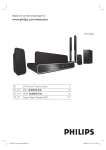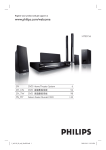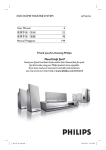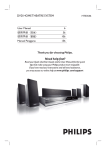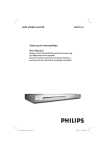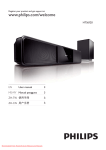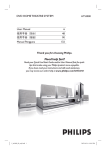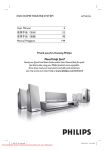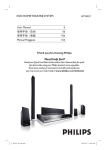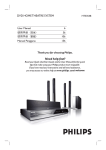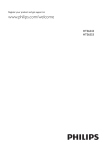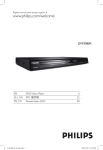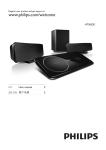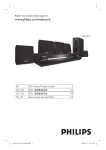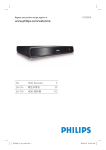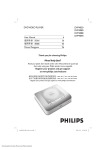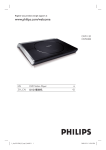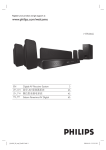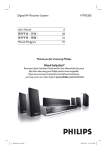Download Philips HTS6515 DVD home theater system
Transcript
Register your product and get support at www.philips.com/welcome HTS6515 EN DVD Home Theatre System 5 ZH_CN DVD 家庭影院系统 51 ZH_TW DVD 家庭劇院系統 97 MS_MY Sistem Teater Rumah DVD 143 ᳝↦᳝ᆇ⠽䋼ܗ㋴ +D]DUGRXV7R[LF6XEVWDQFH 䪙 䚼ӊৡ⿄ 1DPHRIWKH3DUWV 3E/HDG ∲+J 䬝&G 0HUFXU\ &DGPLXP ݁Ӌ䫀 ⒈㘨㣃 &KURPLXP 3%% ⒈Ѡ㣃䝮 3%'(˅ +RXVLQJ O O O O O O '9'ORDGHU '9'Ⲧܝ 6XEZRRIHU 䍙䞡Ԣ䷇ㆅ X O O O O O X O O O O O /RXGVSHDNHUV ুऩܗ O O O O O O 3:%V ⬉䏃ᵓ㒘ӊ X O O O O O $FFHVVRULHV 5HPRWHFRQWURO FDEOHV 䰘ӊ˄䘹఼ˈ ⬉⑤㒓ˈ䖲㒓˅ X O O O O O %DWWHULHVLQ 5HPRWH&RQWURO =Q& 䘹఼⬉∴ X O O O O O ƻ˖㸼⼎䆹᳝↦᳝ᆇ⠽䋼䆹䚼ӊ᠔᳝ഛ䋼ᴤ᭭Ёⱘ䞣ഛ6-7ᷛޚ㾘ᅮⱘ䰤䞣㽕∖ҹϟDŽ O: Indicates that this toxic or hazardous substance contained in all of the homogeneous materials for this part is below the limit requirement in SJ/T11363 – 2006. h˖㸼⼎䆹᳝↦᳝ᆇ⠽䋼㟇ᇥ䆹䚼ӊⱘᶤϔഛ䋼ᴤ᭭Ёⱘ䞣䍙ߎ6-7̢ᷛޚ㾘ᅮⱘ䰤䞣㽕∖DŽ X: Indicates that this toxic or hazardous substance contained in at least one of the homogeneous materials used for this part is above the limit requirement in SJ/T11363 - 2006. 10 ⦃ֱՓ⫼ᳳ䰤Environmental Protection Use Period ℸᷛ䆚ᣛᳳ䰤˄कᑈ˅ˈ⬉ᄤֵᙃѻકЁ᳝ⱘ᳝↦᳝ᆇ⠽䋼ܗ㋴ℷᐌՓ⫼ⱘᴵӊϟϡӮথ ⫳⊘さবˈ⫼᠋Փ⫼䆹⬉ᄤֵᙃѻકϡӮᇍ⦃๗䗴៤Ϲ䞡∵ᶧᇍ݊Ҏ䑿ǃ䋶ѻ䗴៤Ϲ䞡ᤳᆇ ⱘᳳ䰤DŽ This logo refers to the period ( 10 years ) during which the toxic or hazardous substances or elements contained in electronic information products will not leak or mutate so that the use of these [substances or elements] will not result in any severe environmental pollution, any bodily injury or damage to any assets. ⬉∴ᷛ䆚Battery labeling logo ⦃ֱՓ⫼ᳳ䰤Environmental Protection Use Period ℸᷛ䆚ᣛᳳ䰤˄Ѩᑈ˅ˈ⬉∴Ё᳝ⱘ᳝↦᳝ᆇ⠽䋼ܗ㋴ℷᐌՓ⫼ⱘᴵӊϟϡӮথ⫳⊘さ বˈ⫼᠋Փ⫼䆹⬉∴ѻકϡӮᇍ⦃๗䗴៤Ϲ䞡∵ᶧᇍ݊Ҏ䑿ǃ䋶ѻ䗴៤Ϲ䞡ᤳᆇⱘᳳ䰤DŽ This logo refers to the period ( 5 years ) during which the toxic or hazardous substances or elements contained in the battery will not leak or mutate so that the use of these [substances or elements] will not result in any severe environmental pollution, any bodily injury or damage to any assets. 2 3 Manufactured under license from Dolby Laboratories. Dolby, Pro Logic and the double-D symbol are trademarks of Dolby Laboratories. Manufactured under license under U.S. Patent #’s: 5,451,942; 5,956,674; 5,974,380; 5,978,762; 6,487,535 & other U.S. and worldwide patents issued & pending. DTS and DTS Digital Surround are registered trademarks and the DTS logos and Symbol are trademarks of DTS, Inc. © 1996-2007 DTS, Inc. All Rights Reserved. DivX, DivX Ultra Certified, and associated logos are trademarks of DivX, Inc. and are used under license. Official DivX® Ultra Certified product. Plays all versions of DivX ® video (including DivX ® 6) with enhanced playback of DivX® media files and the DivX® Media Format. Windows Media and the Windows logo are trademarks, or registered trademarks of Microsoft Corporation in the United States and/ or other countries. CLASS 1 LASER PRODUCT 4 HDMI, and HDMI logo and High-Definition Multimedia Interface are trademarks or registered trademarks of HDMI licensing LLC. The USB-IF Logos are trademarks of Universal Serial Bus Implementers Forum, Inc. ENERGY STAR and the ENERGY STAR mark are registered U.S. marks ‘CONSUMERS SHOULD NOTE THAT NOT ALL HIGH DEFINITION TELEVISION SETS ARE FULLY COMPATIBLE WITH THIS PRODUCT AND MAY CAUSE ARTIFACTS TO BE DISPLAYED IN THE PICTURE. IN CASE OF 525 OR 625 PROGRESSIVE SCAN PICTURE PROBLEMS, IT IS RECOMMENDED THAT THE USER SWITCH THE CONNECTION TO THE ‘STANDARD DEFINITION’ OUTPUT. IF THERE ARE QUESTIONS REGARDING OUR TV SET COMPATIBILITY WITH THIS MODEL 525p AND 625p DVD PLAYER, PLEASE CONTACT OUR CUSTOMER SERVICE CENTER.’ LASER • Type • Wave length • Output Power • Beam divergence Semiconductor laser GaAIAs 645 - 660 nm (DVD) 770 - 800 nm (CD) 6 mW (DVD) 7 mW (VCD/CD) 60 degrees 1 Important Safety and important notice 2 Your product Features highlight Product overview 3 Connect Place the unit Connect video cables Connect speakers to subwoofer Connect subwoofer Connect radio antenna Connect audio cables/other devices Attach table stand to DVD Home Theatre unit Mount the DVD Home Theatre unit Mount the speakers 4 Get started Prepare the remote control Find the correct viewing channel Select menu display language Start Ambisound setup Turn on Progressive Scan Activate EasyLink control Select a play source 6 6 7 7 8 11 11 12 14 15 15 16 18 18 19 20 20 21 21 22 23 24 25 26 Play from disc Play video Play music Play photo Play from USB device Play from portable media player Play from radio 26 27 30 31 32 33 33 6 Adjust sound 36 Control the volume Adjust Bass/Treble Select Ambisound Select a preset sound effect 36 36 36 37 7 Adjust settings 38 General setup Audio setup Video setup Preference Setup 38 40 41 43 8 Additional information 46 Update software Care Specifications 46 46 47 9 Troubleshooting 48 10 Glossary 50 EN 5 English 5 Play Contents Contents 1 Important Safety and important notice Warning! Risk of fire or electric shock! • Ensure that air can circulate freely through the • • • • • ventilation holes on this unit. Allow at least 5~10 cm clearance around the unit. Never expose this unit to direct sunlight, naked flames or heat. Never place this unit on other electrical equipment. Keep away from this unit during lightning storms. Never remove the casing of this unit. Please leave all maintenance work to qualified personnel. Keep this unit away from water, moisture and liquidfilled objects. Caution! • Remove batteries if they are exhausted or if the remote control is not to be used for a long time. • Do not mix batteries (old and new or carbon and alkaline, etc.). • Batteries contain chemical substances, they should be disposed of properly. • Visible and invisible laser radiation when open. Avoid exposure to beam. • Where the MAINS plug or an appliance coupler is used as the disconnect device, the disconnect device shall remain readily operable. 6 EN Recycle notice This electronic equipment contains a large number of materials that can be recycled or reused if disassembled by a specialised company. If you are disposing of an old machine, please take it to a recycling centre. Please observe the local regulations regarding disposal of packaging materials, exhausted batteries and old equipment. Copyright notice This product incorporates copyright protection technology that is protected by method claims of certain U.S. patents and other intellectual property rights owned by Macrovision Corporation and other rights owners. Use of this copyright protection technology must be authorised by Macrovision Corporation, and is intended for home and other limited viewing uses only unless otherwise authorised by Macrovision Corporation. Reverse engineering or disassembly is prohibited. This DVD Home Theatre is designed to complement your home perfectly. Enjoy the DVD Home Theatre with multi-channel surround sound and excellent picture quality. Features highlight Video upscaling to 1080p You can now watch the DVDs in the highest picture quality available for your HDTV. This DVD Home Theatre offers full high-definition video playback up to 1080p resolution for an amazing viewing experience. A highly detailed picture and increased sharpness delivers a more true-to-life picture. EasyLink EasyLink uses the HDMI CEC (Consumer Electronics Control) industry standard protocol to share functionality with all HDMI CEC compliant devices over HDMI. It enables the connected devices to control each other with a single remote control. Note • Philips does not guarantee 100% interoperability with all HDMI CEC devices. English Congratulations on your purchase, and welcome to Philips! To fully benefit from the support that Philips offers, register your product at www.philips.com/welcome. Ambisound Philips Ambisound technology reproduces multi-channel surround sound with fewer speakers to give an embracing surround experience without the hassle of setting up a full range of speaker systems. USB direct and MP3 link Simply plug your USB device into the USB socket to play your MP3/WMA/JPEG/DivX files; or plug your portable media player to the MP3 LINK socket to enjoy the music play in superb sound quality. Sync the audio output with the video play This DVD Home Theatre provides you the feature of delaying the audio output if the video signals that go directly to the TV is slower than the audio streams. Region codes DVD movies are usually not released at the same time in all regions of the world, thus all DVD players are programmed to a specific region code. Countries DVD region code Asia Pacific, Taiwan, Korea ALL 3 Australia, New Zealand ALL 4 ALL 6 ALL 5 China India EN 7 Your product 2 Your product Product overview Remote control a2 • Turn on this unit or turn off to standby mode. • Press and hold to turn off this unit and all the HDMI CEC compliant TV/ devices (for EasyLink control only). b Z (Open/Close) • Open or close the disc compartment. c Source buttons • DISC: switch to DISC mode. While in disc mode, access or exit disc menu. • USB: switch to USB mode. • RADIO: switch to FM or AM/MW band. • AUX/DI /MP3 LINK: switch to AUX1 INPUT, AUX2 INPUT, AUX3 INPUT, DIGITAL INPUT or MP3 LINK that corresponds to the socket you used to connect the external device. d HDMI • Select a video resolution setting for HDMI output. e INFO • Display the current status or disc information. • Display photo files in 12 thumbnails view. f OPTIONS • Access or exit Options menu (this menu provides various setting options). g u (Play/Pause) • Start or pause disc play. • RADIO: start auto radio installation (only available for first time setup). 8 EN i TREBLE / BASS • Switch to treble or bass mode. Then press VOL +- to set its level setting. j AUDIO SYNC • Select an audio language/channel. • Press and hold to access audio sync setting. Then press VOL +- to set the audio delay time. • RADIO: toggle between FM stereo and mono mode. k SOUND • Select a predefined sound effect. l REPEAT / PROGRAM • Select various repeat or shuffle modes; turns off repeat or shuffle mode. • RADIO: press this button to start manual radio preset. • RADIO: press and hold this button to start automatic radio preset. m OK • Confirm an entry or selection. n Cursor buttons (v V b B) • Navigate through the on-screen menu. • Press left or right for fast backward or forward search. • RADIO: press up or down to tune the radio frequency. • RADIO: press left or right to start auto search. • Return to the previous display menu. • For DVD, go to title menu. • For VCD version 2.0 or SVCD with PBC turned on: return to the menu during playback. English • Stop disc play. • RADIO: erase the current preset radio station. o BACK / TITLE p í/ ë (Previous/Next) Your product h x (Stop) • Skip to the previous or next title/ chapter/track. • RADIO: select a preset radio station. q H (Mute) • Mute or restore the volume. r VOL +• Adjust the volume level. s AMBISOUND • Select different surround sound output: auto, multi-channel or stereo. t Numeric buttons • Enter a preset number or item to play. u SUBTITLE • Select DVD or DivX subtitle language. v ZOOM • Zoom in or out the picture on the TV. w ANGLE • Select a different viewing angle of a DVD movie. EN 9 Main unit 7 MP3 LINK 6 9 5 a 2 (Standby-on) • Turn on this unit or turn off to standby mode. • Press and hold to turn on this unit from a low power standby mode. b u (Play/Pause) • Start or pause disc play. • RADIO: start auto radio installation (only available for first time setup). c VOL +• Adjust the volume level. d SOURCE • Select a play media: DISC, USB, RADIO FM, RADIO AM/MW, DIGITAL INPUT, AUX1 INPUT, AUX2 INPUT, AUX3 INPUT or MP3 LINK. e Z (Open/Close) • Open or close the disc compartment. f Disc compartment 10 8 EN 4 g 3 2 1 (USB) socket • To connect USB flash drive, USB memory reader or digital camera. h MP3 LINK socket • To connect portable audio player. i Display panel Basic connections: • Place the unit • Connect video cables • Connect speakers to subwoofer • Connect subwoofer • Connect radio antenna Optional connections: • Connect audio cables/other devices • Connect audio from TV • Connect audio from cable box/ recorder/game console • Connect portable media player • Connect USB device • Attach table stand to DVD Home Theatre unit • Mount the DVD Home Theatre unit • Mount the speakers. Note • Place this unit on top of a table or mount it on the wall (see chapter ‘Mount the DVD Home Theatre unit’ and ‘Mount the speakers’). • Never place this unit in an enclosed cabinet. • Install this unit near the AC outlet where the AC power plug can be easily reached. LEFT RIGHT 1 2 • Refer to the type plate at the rear or bottom of the product for identification and supply ratings. • Before you make or change any connections, ensure that all the devices are disconnected from the power outlet. 3 Place this DVD Home Theatre unit near to the TV. • Attach the table stand to the DVD Home Theatre unit before place it on a table top. Place the speakers at the normal listening ear-level and directly parallel to the listening area. Place the subwoofer at the corner of the room or at least one metre away from the TV. Note • To avoid magnetic interference or unwanted noise, never place the speakers too close to the TV or any radiation devices. EN 11 English This section describes the basic connections required for this DVD Home Theatre unit before it can be used. Place the unit Connect 3 Connect Connect video cables This section describes how to connect this DVD Home Theatre unit to your TV so to enable viewing of disc play. Before you connect 1 Push up the catch and remove the rear cover. Select the best video connection that your TV can support. Option 1: Connect to HDMI socket (for a HDMI, DVI or HDCP-compliant TV). Option 2: Connect to component video socket (for a standard TV or Progressive Scan TV). Option 3: Connect to video (CVBS) socket (for a standard TV). • • • Note • You must connect this unit directly to a TV. 2 3 Connect the cables to the corresponding sockets and direct the cables to the open hole on top. Once complete, close the rear cover. Note • All the cables must be placed properly inside the rear panel in order for the rear cover to close. 12 EN English Option 2: Connect to component video socket Connect Option 1: Connect to HDMI socket HDMI OUT COMPONENT VIDEO OUT HDMI IN 1 Connect a HDMI cable (supplied) from the HDMI OUT on this unit to the HDMI IN socket on your TV. Note • The HDMI connector is only compatible with HDMI compliant TVs and DVI-TVs. Tips • To optimise the video output, see chapter ‘Adjust • • • • settings’ > [ Video Setup ] > [ HDMI Setup ] for details. This unit is HDMI CEC compatible. It enables connected TV/device to control each other over HDMI, see chapter ‘Activate EasyLink control’ for details. Use a HDMI/DVI adaptor in case your TV has only a DVI connection. An extra audio connection is needed to complete this connection. To route the audio from your TV to this DVD Home Theatre unit, connect an audio cable from the audio input on this unit to the audio output on your TV. This type of connections provide best picture quality. 1 Connect the component video cable (supplied) from the COMPONENT VIDEO OUT socket on this unit to the component video input sockets on your TV. • If a progressive scan TV is used, you may turn on the progressive scan mode (see chapter ‘Turn on Progressive Scan’ for details). Tips • The component video input socket on your TV may be labelled as Y Pb/Cb Pr/Cr or YUV. • This type of connections provide good picture quality. EN 13 Option 3: Connect to Video (CVBS) socket Connect speakers to subwoofer LEFT RIGHT 1 1 Connect a composite video cable (supplied) from the VIDEO OUT socket on this unit to the video input socket on your TV. Connect the left and right Ambisound speakers to the matching sockets on the subwoofer. Note • Ensure that the front portion of the plug is fully inserted into the socket. • To disconnect the Ambisound speakers, press down Tips • The video input socket on your TV may be labeled as A/V IN, VIDEO IN, COMPOSITE or BASEBAND. • This type of connections provide standard picture quality. 14 EN the catch on the plug before pulling out. Connect radio antenna English Connect subwoofer Connect 3 4 2 1 TO SUBWOOFER 1 1 2 Unwind the subwoofer’s interconnect cable at TO MAIN UNIT and connect it to the TO SUBWOOFER socket on this unit. 3 4 Stand the AM/MW loop antenna (supplied) upright to fix its claw into the slot. Connect the AM/MW loop antenna to the AM/MW socket. Then place the AM/MW loop antenna on a shelf, or attach it to a stand or wall. Connect the FM antenna (supplied) to the FM75Ω socket on this unit (for some models, this cable has been connected). Extend the FM antenna and fix its ends to the wall. Connect the power cord when all the required connections are complete and you are ready to enjoy this DVD Home Theatre unit. Note • Before connect to power outlet, ensure that the voltage selector (at the rear of this unit) is set to the local power line voltage. EN 15 Connect audio cables/other devices This section describes how you can route the sound from other devices to this DVD Home Theatre unit in order to enjoy sound output or audio play with multi-channel surround capabilities. Connect audio from cable box/ recorder/game console You can choose to connect to analogue or digital socket depending on the device capabilities. Connect to analogue sockets Connect audio from TV (also used for EasyLink control) 1 1 Connect an audio cable (not supplied) from the AUDIO IN-AUX1 sockets on this unit to the AUDIO OUT sockets on your TV. Connect an audio cable (not supplied) from the AUDIO IN-AUX2 or AUX3 sockets on the subwoofer to the AUDIO OUT sockets on the device. Note • To listen to the audio output from this connection, Note • To listen to the audio output from this connection, press AUX/DI /MP3 LINK repeatedly until ‘AUX1 INPUT’ is displayed on the display panel. 16 EN press AUX/DI /MP3 LINK repeatedly until ‘AUX2 INPUT’ or ‘AUX3 INPUT’ is displayed on the display panel. Connect portable media player English Connect to digital socket MP3 LINK COAXIAL DIGITAL IN 1 1 Connect a coaxial cable (not supplied) from the DIGITAL IN-COAXIAL socket on the subwoofer to the COAXIAL/ DIGITAL OUT socket on the device. Connect MP3 Connect a 3.5mm stereo audio cable (not supplied) from the MP3 LINK socket on this unit to the phone socket on your portable media player (such as MP3 player). Note • To listen to the audio output from this connection, press AUX/DI /MP3 LINK repeatedly until ‘MP3 LINK’ is displayed on the display panel. Note • To listen to the audio output from this connection, press AUX/DI /MP3 LINK repeatedly until ‘DIGITAL INPUT’ is displayed on the display panel. Connect USB device 1 Connect the USB device to socket on this unit. (USB) Note • This unit can only play/view MP3, WMA, DivX (Ultra) or JPEG files that are stored on such devices. • To listen to the audio output from this connection, press USB. EN 17 Attach table stand to DVD Home Theatre unit 1 2 Ensure all the required cables are connected to this unit and close the rear cover. Attach the table stand bracket to the rear of this unit. • Align the arrow indicators for correct positioning and placement. • Use the protrude panels to hold the table stand bracket. Mount the DVD Home Theatre unit Caution! • Risk of personal injury and damage to the unit. Allow only qualified persons to mount the unit. 1 2 Ensure all the required cables are connected to this unit and close the rear cover. Attach the big wall mount bracket to table stand bracket with screws. B A A Align Arrow With table Stand A table stand bracket B big wall mount bracket Align Arrow With table Stand 3 Position the brackets on the wall, drill four screw holes and secure the brackets onto the wall with screws (not supplied). A Align Arrow With table Stand 4 A A table stand bracket 18 EN Hook the DVD Home Theatre unit firmly onto the mounted bracket. English Mount the speakers Caution! • Risk of personal injury and damage to the unit. 1 5 Connect Allow only qualified persons to mount the unit. Loosen the screws at the bottom of the speaker to remove the speaker stand. Screw the supplied knob to the hole at the centre rear to secure the DVD Home Theatre unit to the bracket. 2 3 Attach the small wall mount bracket to the speaker with screws. Fix two screws (not supplied) to the wall, then hook the bracket onto the screws and lock the speaker into position. EN 19 4 Get started Control a play source 1 Prepare the remote control 2 Select the source you wish to control by pressing the DISC, USB, RADIO or AUX/DI/MP3 LINK button. Then select the desired function (for example í, ë). Navigate through the menu 1 1 2 3 Point the remote control directly at the remote sensor on this unit and select the desired function. Push to open the battery compartment cover. Insert two batteries type R03 or AAA. Match the indications (+-) inside the battery compartment. Close the cover. Note 2 Use the following buttons on the remote control to navigate through the on-screen menus. Button vV Action Move up or down. bB Move left or right. • If you are not going to use the remote control for a long time, remove the batteries. Confirm a selection. Enter numbers. 20 EN Select menu display language English Find the correct viewing channel Note 2 3 Press 2 to turn on the DVD Home Theatre unit. • You can skip this setting if this unit is connected to a HDMI CEC compliant TV. It switches automatically to the same OSD menu language as per your TV setting. Press DISC to switch to disc mode Turn on the TV and switch it to the correct video-in channel. • You may go to the lowest channel on your TV, then press the Channel Down button on your TVs remote control until you see the Video In channel. • You may press ° button repeatedly on your TVs remote control. • Usually this channel is between the lowest and highest channels and may be called FRONT, A/V IN, VIDEO, etc.. 1 2 3 4 Get started 1 Press DISC. Press OPTIONS. [ General Setup ] menu is displayed. Press B. Press vV to select [ OSD Language ] in the menu, then press B. General Setup Tips EasyLink Auto Disc Lock English Display Dim OSD Language • See the TVs user manual on how to select the correct input on your TV. Screen Saver Melayu Sleep Timer Русский Standby Mode ไทย DivX(R) VOD Code • The language options are different depending on your country or region. It may not correspond to the illustration shown here. 5 Press vV to select a language, then press OK. Tips • To set the default language for DVD audio and disc menu, see chapter ‘Adjust settings’ - [ Preference Setup ] for details. EN 21 Start Ambisound setup 5 Change the Ambisound setup according to your room environment and setup in order to obtain the best possible surround sound effect. 1 2 3 Type of wall that surround your room. [ Room Acoustics ] • [ Hard ] (concrete, wood) • [ Soft ] (curtains, open space) Press DISC. Press OPTIONS. Speakers placement in your room. Press V to select [ Audio Setup ] in the menu, then press B. [ Room Placement ] • [ Middle of room ] • [ Corner of room ] • [ Near the right wall ] • [ Near the left wall ] Audio Setup Ambisound Setup HDMI Audio Night Mode Distance between two speakers. [ Speaker Distance ] • [ Near ] (< 2m / 78in) • [ Default ] (2m~3m / 78~118in) • [ Far ] (> 3m / 118in) • To access Ambisound setup option, this DVD Home Theatre unit must be in a complete stop mode. Press x twice if necessary. 4 Distance between the listening position and the speakers. Select [ Ambisound Setup ] in the menu, then press B. [ Listening Position ] • [ Near ] (< 2m / 78in) • [ Default ] (2m~3m / 78~118in) • [ Far ] (> 3m / 118in) Ambisound Setup Room Acoustics Hard Room Placement Soft Speaker Distance Listening Position 22 EN Select a setup you want to change, then press B. 6 7 Press vV to select a setting, then press OK. To exit the menu, press OPTIONS. 1 2 3 4 Turn on the TV to the correct viewing channel for this unit. Press DISC. To exit the menu, press OPTIONS. You can now turn on the progressive scan mode on your TV (see the TV user manual). Note • There are some progressive scan TVs that are not fully compatible with this unit, resulting in an unnatural picture when playing back a DVD VIDEO disc in the progressive scan mode. In such case, turn off the progressive scan feature on this unit and your TV. Press OPTIONS. Press V to select [ Video Setup ] in the menu, then press B. Video Setup TV Type On TV Display Off Picture Settings HDMI Setup Closed Caption Progressive 5 6 Select [ Progressive ] > [ On ], then press OK. A warning message is displayed. To proceed, select [ OK ] in the menu and press OK. The progressive setup is complete. Note • If a blank/distorted screen is displayed, wait for 15 seconds for the auto recover. • If no picture displayed, turn off the progressive scan mode as follows: 1) Press Z to open the disc compartment. 2) Press B. 3) Press SUBTITLE. EN 23 English If you connect this unit to TV with the component video connection (see chapter ‘Connect video cables - Option 2: Connect to component video socket’ for details), you can turn on the progressive scan output if your TV supports progressive scan. 7 8 Get started Turn on Progressive Scan Activate EasyLink control This feature is only applicable if this unit is connected to HDMI CEC compliant TV/device. It enables all the linked devices response or react to certain commands simultaneously with one touch control. 1 2 Turn on the HDMI CEC operations on your TV and other connected devices. See TVs/devices manual for details. You can now enjoy the EasyLink controls. One touch play [ Auto Wake-up TV ] When you press PLAY button, this unit will wake- up from standby mode and start disc play (if a video disc is found in the disc compartment) and it will also turn on your TV and switch to the correct viewing channel. One touch power off [ System Standby ] When you press and hold STANDBY button, it will turn off this unit and all the linked devices to standby. This unit also responses to standby command from other HDMI CEC devices. One touch audio input switching [ System Audio Control ] This unit is able to render the audio signals from the active source. It switches automatically to the corresponding audio input and output the sound from its speaker system. • Before you can enjoy this function, you have to map the audio inputs to the connected devices. • You can use any HDMI CEC TV/device remote control to adjust the volume. 24 EN Note • To enable one touch play function, a video disc must be placed in the disc compartment before operation. • Philips does not guarantee 100% interoperability with all HDMI CEC compliant devices. Map the audio inputs to the connected devices Note • Before you start, ensure that an audio connection has been made between this unit and your TV/ devices. 1 2 3 4 Press DISC. Press OPTIONS. [ General Setup ] menu is displayed. Press B. Select [ EasyLink ], then press B. General Setup EasyLink Auto Wake-up TV Disc Lock System Standby Display Dim System Audio Control OSD Language Audio Input Mapping Screen Saver Sleep Timer Standby Mode DivX(R) VOD Code • [ Auto Wake-up TV ] and [ System Standby ] functions are turned on by default in the factory. 5 6 Select [ System Audio Control ] > [ On ], then press OK. Select [ Audio Input Mapping ], then press OK. Select [ OK ] in the menu, then press OK to start scanning of devices. Once complete, audio input mapping menu is displayed. Select a play source English 7 On the main unit AUX1 Input TV AUX2 Input Other (non-HDMI) Get started Audio Input Mapping AUX3 Input Digital Input 1 • For example, if your TV audio is connected to the AUX IN-AUX 1 sockets on this unit, select [ AUX1 Input ] and map with the TV (brand name) at the right panel. 8 9 Press SOURCE button repeatedly to select: DISC > USB > RADIO FM > RADIO AM/MW > DIGITAL INPUT > AUX1 INPUT > AUX2 INPUT > AUX3 INPUT > MP3 LINK > DISC ... On the remote control Select the audio input of this unit that is used to connect to other HDMI device (e.g. AUX1 Input, AUX2 Input), then press B. Select the correct device that connected to this audio input, then press OK. • Repeat steps 8~9 to map other connected devices. 10 To exit the menu, press OPTIONS. • Press DISC to switch to DISC mode. • Press USB to switch to USB mode. • Press RADIO to switch to FM or AM/MW band. • Press AUX/DI /MP3 LINK repeatedly to select other external devices. Display Device connected to AUX1 INPUT AUDIO IN-AUX1 sockets. AUX2 INPUT AUDIO IN-AUX2 sockets. AUX3 INPUT AUDIO IN-AUX3 sockets. DIGITAL INPUT DIGITAL IN-COAXIAL socket. MP3 LINK MP3 LINK socket. EN 25 5 Play Note • DVDs and DVD players are designed with regional Play from disc • Play a disc Playable discs DVD Video • Region 3 (Asia Pacific, Taiwan, Korea) • Region 4 (Australia, New Zealand) • Region 6 (China) • Region 5 (India) DVD±RW (DVD Rewritable) DVD±R (DVD Recordable) Caution! • Never place any objects other than discs into the disc compartment. • Never touch the disc optical lens inside the disc compartment. 1 2 3 DVD+R DL (DVD+R Double Layer) CD-RW (CD-Rewritable) 4 ReWritable Insert a disc with its label facing up. • For double-sided disc, load the side to play faces up. Press Z to close the disc compartment and start disc play. • To view disc play, turn on the TV to the correct viewing channel for this DVD Home Theatre unit. To stop disc play, press x. • If the password entry menu is displayed, you have to Enter the 6-digit password before it can be played. Recordable • Screen saver displays automatically if the disc play Audio CD (Compact Disc Digital Audio) Video CD • Formats 1.0, 1.1, 2.0 Super Video CD EN Press Z to open the disc compartment. Tips CD-R (CD-Recordable) 26 restrictions. Ensure that the DVD video you play is for the same region zone as your player (indicated on its rear). This unit can support playback of the following file formats: MP3/WMA/JPEG/DivX. • is stopped for about 15 minutes. To wake up from screen saver, press DISC. This unit automatically switches to standby mode if you do not press any buttons within 30 minutes after a disc has stopped playing. Play video • For video disc, playback always resumes from the point where it was last stopped. To start playback from the beginning, press í while the message is displayed. Control a title 1 2 Play a title. Use the remote control to control the title. Button 1 2 Play a title. Use the remote control to change the video play. Button Play Note English Change video play Action Change audio language. • Only applicable to discs with multiple audio language or channel. Change subtitle language. • Only applicable to discs with multiple subtitle language. Jump to the next title/chapter. Toggle through various repeat/ shuffle play mode; or turn off repeat mode. • Repeat options vary depending on the disc type. • For VCDs, repeat play is only possible when the PBC mode is turned off. Return to the beginning of the current title/chapter or jump to the previous title/chapter. Zoom in/out. • To pan through the zoomed image, press the cursor buttons. Action Pause/ resume play. Stop play. m M Search backward/ forward. • To change search speed, press this button repeatedly. vV Slow motion reverse/ forward play. • To change play speed, press this button repeatedly. • For VCD, only forward play is possible. Display current play status. • You can change the video play options here without interrupting disc play. View DVD play from different camera angles. • Only applicable to DVDs that contain sequences recorded from different camera angles. EN 27 Access DVD menu Sync audio output with video play If the video play is slower than the audio output (sound does not match with the pictures), you can delay the audio output to match the video. 1 2 Press DISC to access disc main menu. Select a play option, then press OK. • In some menus, press number buttons to input your selection. • To return to the title menu during playback, press TITLE. Access VCD menu The PBC (Playback Control) for VCD is turned on by default in the factory. When you load in a VCD, the contents menu is displayed. 1 Press vV to select a play option, then press OK to start play. • If PBC is off, it skips the menu and starts play from the first title. • During playback, you can press BACK to return to the menu (if the PBC mode is on). Tips • The default setting for PBC is on. To change the default setting, see chapter ‘Adjust settings’ [ Preference Setup ] > [ PBC ] for details. 28 EN 1 2 Press and hold AUDIO SYNC until ‘AUDIO SYNC XXX’ is displayed. • ‘XXX’ denotes the delay time. Within five seconds, press VOL +- to set the delay time for audio output. Note • If the volume control is not used within 5 seconds, it resumes normal volume control function. 1 2 3 During playback, press INFO. The disc status menu is displayed. Select the current elapsed playing time in the menu, then press OK. • [ TT Time ] (title time) • [ CH Time ] (chapter time) • [ Disc Time ] (disc time) • [ Track Time ] (track time) DivX video is a digital media format that retains high quality despite a high rate of compression. This unit is DivX® Certified that allows you to enjoy DivX video. English Play DivX® video 1 Play Quick skip play to a specific time 2 3 4 Insert a disc or USB that contains the DivX videos. Press DISC or USB. A contents menu is displayed. Select a title to play, then press u. Use the remote control to control the title. Button Press the number buttons to change the time where you want to skip to, then press OK. Action Change subtitle language. Change audio language/track. Stop play. • For DivX Ultra video, press this button again to display the contents menu. Display DivX Ultra video information. Note • Only those DivX videos that were rented or • • • purchased using the DivX registration code of this unit can be played (see chapter ‘Adjust settings’ > [ General Setup ] > [ DivX(R) VOD Code ] for details). If the subtitle does not appear correctly, change the subtitle language (see chapter ‘Adjust settings’ [ Preference Setup ] > [ DivX Subtitle ] for details). The subtitle can only be displayed up to an average of 45 characters. This unit can play DivX video files that are up to 4GB in size. EN 29 Play music Play MP3/WMA music MP3/WMA is a type of highly compressed audio file (files with .mp3 or .wma extensions). Note • For some commercial audio disc, playback may resume from the point where it was last stopped. To start playback from first track, press í. 1 2 Control a track 1 2 Play a track. 3 4 Use the remote control to control the track. Button Action Pause/ resume play. Insert a disc or USB that contains the MP3/ WMA music. Press DISC or USB. A contents menu is displayed. Select a folder, then press OK. Select a track to play, then press u. • To return to the main menu, press v until ‘Previous’ folder is selected, then press OK. Note • For CDs recorded in multiple sessions, only the first session is played. Stop play. • This unit does not support MP3PRO audio format. • If any special characters are present in the MP3 track Jump to the next track. • Return to the beginning of the current track or jump to the previous track. Direct input the track number. • name (ID3) or album name, it might not be displayed correctly on the screen because these characters are not supported. Some WMA is protected by Digital Rights Management (DRM), it cannot be played on this unit. Folders/files exceed the supported file limit of this unit will not be displayed or played. Tips • To display the data disc contents without folders, see m M Search backward/ forward. • To change search speed, press this button repeatedly. Toggle through various repeat/ shuffle play mode; or turn off repeat mode. • Repeat options vary depending on the disc type. 30 EN chapter ‘Adjust settings’ - [ Preference Setup ] > [ MP3/JPEG Nav ] for details. Play photo Play photos as slideshow This unit can play JPEG photos (files with .jpeg or .jpg extensions). 1 2 3 Insert a disc or USB that contains the JPEG photos. Press DISC or USB. For a Kodak disc, the slideshow begins automatically. For a JPEG disc, the photo menu is displayed. Select the folder/album you want to play. • To preview the photos in the folder/ album, press INFO. • To go to previous or next screen display, press í / ë. • To select a photo, press the cursor buttons. • To display the selected photo only, press OK. 4 • • • contents on the TV due to the large number of songs/photos compiled onto one disc. If the JPEG photo is not recorded with an ‘exif ’ type file, the actual thumbnail picture will not be shown on the display. It will be replaced with a ‘blue mountain’ thumbnail picture. This unit can only display digital camera pictures according to the JPEG-EXIF format, typically used by almost all digital cameras. It cannot display Motion JPEG and pictures in formats other than JPEG, or sound clips associated with pictures. Folders/files exceed the supported file limit of this unit will not be displayed or played. Control photo play 1 2 Play photo slideshow. Use the remote control to control the photo. Button Action b Skip to the previous photo. B Skip to the next photo. v Rotate the photo clockwise. V Rotate the photo anticlockwise. Zoom in/ out. • Play will pause while in zoom mode. Stop play. Press u to start slideshow play. • To return to the menu, press BACK. EN 31 Play • It may require longer time to display the disc English Note Play musical slideshow Play from USB device Play MP3/WMA music files and JPEG photo files simultaneously to create musical slideshow. The MP3/WMA and JPEG files must be stored on the same disc or USB device. This unit can only play/view MP3, WMA, DivX (Ultra) or JPEG files that are stored on such devices. 1 2 3 4 Play MP3/WMA music. Navigate to the photo folder/album and press u to start slideshow play. Slideshow begins and continues till the end of the photo folder or album. Audio continues to play till the end of the disc. • To return to the menu, press BACK. 1 To stop slideshow play, press x. To stop music play, press x again. 2 3 4 Connect a digital camera that comply with the PTP standard, USB flash drive, or USB memory card reader to the (USB) socket on this unit. Press USB. A contents menu is displayed. Select a file to play, then press u. • For more information, see chapters ‘Play music, Play photo, Play video’ for details. To stop play, press x or remove the USB device. Tips • If the device does not fi t into the USB socket, connect it through a USB extension cable. • If a multiple USB card reader is used, only one of the connected USB drive contents can be accessed. • If a USB HDD is used, ensure that an auxiliary • 32 EN power cord connected to the USB HDD for proper operations. Digital cameras that use PTP protocol or require additional programme installation when connected to a PC are not supported. Check if the FM antenna has been connected to the subwoofer. If not, connect the supplied FM antenna to the FM 75Ω socket and fix its ends to the wall. Play Simply connect your portable media player (e.g. MP3 player) to this unit to enjoy superb sound quality from your music collections. Play from radio English Play from portable media player MP3 LINK 1 2 3 4 MP3 Connect a 3.5mm stereo audio cable (not supplied) from the MP3 LINK socket on this unit to the ‘headphone’ socket on your portable media player. Press AUX/DI /MP3 LINK repeatedly until ‘MP3 LINK’ is displayed. Start play on your portable media player. • See chapter ‘Adjust Sound’ to enhance the audio output. To stop play, press STOP button on your portable media player. Note Note • For China/Latin America region only, if you want to receive AM/MW radio band, connect the AM loop antenna (supplied) to the AM/MW sockets on this DVD Home Theatre unit. Tips • For better FM stereo reception, connect an external FM antenna (not supplied). • Position the antenna as far away as possible from your TV, VCR or other radiation source to prevent unwanted interference. • Control playback is only possible on your portable media player. • Stop play on the portable media player before you switch to other play media/source. EN 33 First time tuning Listen to radio The first time when you access ‘RADIO’ mode, follow the instructions to install the radio stations. 1 1 2 Press RADIO. ’AUTO INSTALL ... PRESS PLAY’ is displayed. Press u. All detected radio stations are stored. Once complete, it tunes to the first preset radio station. • To stop auto tuning, press x. 2 Press RADIO repeatedly to select ‘FM’ or ‘AM/MW’ band. Use the remote control to control the radio. Button Action Select a preset radio station. m M Tune the radio frequency backward/ forward. Toggle between FM stereo and FM mono mode. Note Press and hold this button to delete the preset station from the preset list. • The preset number for other radio stations remain unchanged • This unit can store up to a maximum of 40 FM radio stations (20 radio stations for AM/MW band). • If auto installation is not activated or less than 5 radio stations are stored, ‘AUTO INSTALL’ will be displayed again the next time you turn on to radio mode. Reinstall all the radio stations 1 2 Press RADIO repeatedly to select ‘FM’ or ‘AM/MW’ band. Press and hold PROGRAM until ‘STARTING INSTALL’ is displayed. All previously stored radio stations will be replaced. Note • If no stereo signal is detected or less than 5 stations are detected during radio installation, ‘CHECK ANTENNA’ is displayed. 34 EN 2 3 4 5 6 Press RADIO repeatedly to select ‘FM’ or ‘AM/MW’ band. Press m M. The radio frequency indication starts to change until a radio station is detected. Play 1 English Search and store radio stations individually Repeat step 2 until you tune to the radio station you wish to store. • To finetune the radio frequency, press vV. Press PROGRAM. • If no action is carried out within 20 seconds after the above step, it exits the preset mode. Press í ë (or the number buttons) to select a preset number to store. Press PROGRAM to confirm. Change tuning grid In some countries, the frequency step between adjacent channels in FM band is 50 kHz or 100 kHz (AM/MW band is 9 kHz or 10 kHz). Note • This feature only applicable for certain region. • Change tuning grid erases all preset radio stations. 1 2 3 Press RADIO repeatedly to select ‘FM’ or ‘AM/MW’ band. Press x. Press and hold u until ‘GRID 9’ or ‘GRID 10’ is displayed. • ‘GRID 9’ for FM 50 kHz (or AM 9 kHz) and ‘GRID 10’ for FM 100 kHz (or AM 10 kHz). EN 35 6 Adjust sound Select Ambisound Control the volume 1 Press VOL +- to increase or decrease the volume level. • To mute the volume, press H. • To restore the volume, press H again or press the volume button. Adjust Bass/Treble 1 2 Press BASS / TREBLE. Press VOL +-repeatedly to set the level for low (BASS) or high (TREBLE) tone. Note • If the volume control is not used within 10 seconds, it resumes normal volume control function. 36 EN 1 Press AMBISOUND repeatedly to select a best surround output that most suits the video or music you play. Options Descriptions AUTO The surround output will be selected based on the audio stream of the played content. MULTICHANNEL Multi-channel surround sound. STEREO Stereo sound. 1 Adjust sound English Select a preset sound effect Press SOUND repeatedly to select a sound effect that most suits the video or music you play. Video / Music / Descriptions ACTION / ROCK / Enhanced low and high range for great sounding movie effects and atmosphere. Great for action movies and rock/pop music. DRAMA / JAZZ Clear mid and high range. Recreates the atmosphere of a live club with the artist just in front of you. Good for Jazz music and watching dramas. CONCERT / CLASSIC Flat and pure sound mode. Ideal for listening to classical music and watching live concert DVDs. GAMING / PARTY Slightly enhanced low range and strong mid range ideal for party music and video gaming. SPORTS Moderate mid range and surround effects for clear vocals and the atmosphere of a live sports venue. NEWS Enhanced mid range for clear vocals/speech. EN 37 7 Adjust settings This section describes the various setting options of this unit. Symbol Options [ EasyLink ] This feature is only applicable if this unit is connected to HDMI CEC compliant TV/ device. It enables all the linked devices response or react to certain commands simultaneously with one touch control. [ General Setup ] Options Descriptions [ Audio Setup ] [ Auto Wakeup TV ] It wake-ups your TV automatically when you press PLAY to power up this unit and start disc play (if a video disc is found in the disc compartment). • To disable this feature, select [ Off ]. [ System Standby ] Respond to standby command from other HDMI CEC compliant TV/devices. • To disable this feature, select [ Decline ]. [ Video Setup ] [ Preference Setup ] General setup 1 2 3 Press OPTIONS. [ General Setup ] menu is displayed. Press B. Select an option, then press OK. General Setup EasyLink Disc Lock Display Dim OSD Language Screen Saver Sleep Timer Standby Mode DivX(R) VOD Code • See the explanations of the above options in the following pages. 4 38 Select a setting, then press OK. • To return to the previous menu, press BACK. • To exit the menu, press OPTIONS. EN [ System Audio It enables this DVD Control ] Home Theatre unit to switch automatically to the audio input of the active device. • To enable this feature, select [ On ]. Then proceed to [ Audio Input Mapping ] to scan and map all the connected devices. Note • Your TV and other connected devices must be compliant with HDMI CEC. • You must turn on the HDMI CEC operations on • your TV/devices before you can enjoy the EasyLink controls. See your TVs/devices manual for details. Philips does not guarantee 100% interoperability with all HDMI CEC compliant devices. [ Disc Lock ] Set play restriction for a specific discs. Before you start, place the disc in the disc compartment (maximum 40 discs can be locked). • [ Lock ] – restrict access to the current disc. The next time you want to play this disc or unlock it, you need to enter the password. • [ Unlock ] – all discs can be played. Tips • To set or change your password, go to [ Display Dim ] Change the brightness level of the display panel to suit the lighting in your room. • [ 100% ] – normal brightness. • [ 70% ] – medium brightness. • [ 40% ] – dimmest display. The LEDs and display icons will not be shown. [ OSD Language ] Select the default on-screen menu language. [ Screen Saver ] Turn off or on the screen saver mode. It helps to protect the TV screen from being damage due to over exposure to a static image for too long. • [ On ] – set the screen saver to appear after 15 minutes of inactivity (for example, in pause or stop mode). • [ Off ] – disable screen saver mode. [ Sleep Timer ] Switch to standby automatically after the preset time. • [ Off ] – disable sleep mode. • [ 15, 30, 45, 60 mins ] – select the count down time before it switches to standby. [ Standby Mode ] Set the standby mode. • [ Normal ] – normal standby power consumption. • [ Low Power ] – low standby power consumption. However, it requires longer time to power up. [ Preference Setup ] > [ Password ]. EN 39 English Map the audio input to the connected TV/ devices correctly to enable automatic switching of input source. 1. Press OK to start scanning of devices. 2. Select the audio input to map (e.g. AUX1 Input, AUX2 Input), then press B. 3. Select the correct device that connected to this audio input, then press OK. Adjust settings [ Audio Input Mapping ] [ DivX(R) VOD Code ] Display the DivX® registration code. Tips • Enter this unit’s DivX registration code when you rent or purchase video from www.divx.com/vod. The DivX videos rented or purchased through the DivX® VOD (Video On Demand) service can be played only on the device to which it is registered. Audio setup 1 2 3 Press OPTIONS. [ General Setup ] menu is displayed. Press V to select press B. [ Audio Setup ], then Select an option, then press OK. Audio Setup Ambisound Setup HDMI Audio Night Mode 4 40 EN Select a setting, then press OK. • To return to the previous menu, press BACK. • To exit the menu, press OPTIONS. Options Descriptions [ Room Acoustics ] Select the type of walls that surround your room. [ Room Placement ] Select this unit placement in the room. [ Speaker Distance ] Select the distance between two speakers. [ Listening Position ] Select the distance between your listening position and this unit. Video setup 1 2 3 English Change the Ambisound setup. Press OPTIONS. [ General Setup ] menu is displayed. Press V to select press B. [ Video Setup ], then Adjust settings [ Ambisound Setup ] Select an option, then press OK. Video Setup TV Type TV Display Picture Settings HDMI Setup Closed Caption Tips Progressive • See chapter ‘Get Started - Start Ambisound setup’ for detailed information. • See the explanations of the above options in the following pages. [ HDMI Audio ] When you connect this unit and TV with HDMI cable, select the audio output setting for this connection. • [ On ] – the sound is output through both your TV and this speaker system. If the audio format on the disc is not supported, it will be downmixed to two-channel sound (linear-PCM). • [ Off ] – disable audio output from your TV. The sound is only output through this speaker system. 4 Select a setting, then press OK. • To return to the previous menu, press BACK. • To exit the menu, press OPTIONS. [ Night Mode ] Make loud sound level softer and soft sound level louder so that you can watch the DVD movies at a low volume, without disturbing others. • [ On ] – for quiet viewing at night (DVDs only). • [ Off ] – enjoy surround sound with a full dynamic range. EN 41 [ TV Type ] [ HDMI Setup ] Change this setting only if the video does not appear correctly. By default, this setting matches the most common setting for TVs in your country. • [ PAL ] – for PAL-system TV. • [ NTSC ] – for NTSC-system TV. • [ Multi ] – for TV that is compatible with both PAL and NTSC. When you connect this unit and TV with HDMI cable, select the best HDMI setup that your TV can support. • [ Wide Screen Format ] – define the wide screen format for disc play. Options Descriptions [ Superwide ] Centre position of the screen is stretched less than the side. This setting is only applicable if the video resolution is set to 720p or 1080i/p. [ 4:3 Pillar Box ] No stretching of the picture. Black bars are displayed on both sides of the screen. [ Off ] Picture will be displayed according to the format of the disc. [ TV Display ] Select the screen format according to how you want the picture to appear on your TV. 4:3 Pan Scan (PS) 4:3 Letter Box (LB) 16:9 (Wide Screen) • [ 4:3 Pan Scan ] – for standard TV, a full-height screen display with the sides trimmed. • [ 4:3 Letter Box ] – for standard TV, a ‘wide-screen’ display with black bars on the top and bottom. • [ 16:9 Wide Screen ] – for wide-screen TV (frame ratio 16:9). [ Picture Settings ] Select a predefined set of picture colour settings or customise your personal setting. • [ Standard ] – original colour setting. • [ Bright ] – vibrant colour setting. • [ Soft ] – warm colour setting. • [ Personal ] – customise the colour setting. Set the level of brightness, contrast, tint and colour saturation in the menu, then press OK. 42 EN Note • This setting is only available if you have set the [ TV Display ] setting to [ 16:9 Wide Screen ]. • [ HDMI Video ] – select a video resolution that is compatible with your TV display capability. Options Descriptions [ Auto ] It detects and selects the best supported video resolution automatically. [ 480p, 576p, 720p, 1080i, 1080p ] Select a video resolution that best supported by your TV. See your TVs manual for details. blank screen appears. Wait for 15 seconds for auto recover or press HDMI repeatedly until the picture appears. [ Closed Caption ] Turn on or off display captions. • [ On ] – show the sound effects in subtitle. Only applicable to disc with Closed Caption information included and your TV supports this feature. • [ Off ] – disable closed caption. 1 2 3 Tips • See chapter ‘Get Started - Turn on Progressive Scan’ for detailed information. Press OPTIONS. [ General Setup ] menu is displayed. Press V to select then press B. [ Preference Setup ], Select an option, then press OK. Preference Setup Audio Subtitle Disc Menu [ Progressive ] If your TV can support progressive signals, you can activate the progressive scan mode of this unit. • [ On ] – turn on progressive scan mode. • [ Off ] – disable progressive scan mode. English • If the setting is not compatible with your TV, a Preference Setup Adjust settings Note Parental PBC MP3/JPEG Nav Password DivX Subtitle • See the explanations of the above options in the following pages. 4 Select a setting, then press OK. • To return to the previous menu, press BACK. • To exit the menu, press OPTIONS. EN 43 [ Audio ] [ PBC ] Select the default audio language for DVDs. For VCDs/SVCDs recorded with PBC (playback control,) you can access the disc contents through an interactive menu. • [ On ] – an index menu is displayed when you load a disc for play. • [ Off ] – skip the menu and start play from the first title. [ Subtitle ] Select the default subtitle language for DVDs. [ Disc Menu ] Select the menu language for DVDs. Note • If the language you have set is not available on the disc, the disc uses its own default language. • For some DVDs, the subtitle/audio language can only be changed from the disc menu. • To select the languages that are not listed in the menu, select [ Others ]. Then check the Language Code list at the back of this user manual and Enter the respective 4-digit language code. [ Parental ] Restrict access to DVDs that are unsuitable for your children. These types of DVDs must be recorded with ratings. 1. To start, press OK. 2. Select a rating level in the menu, then press OK. 3. Press the number buttons to Enter your 6-digit password. Note • Rated DVDs above the level you set in [ Parental ] require a password to be played. • The ratings are country-dependent. To allow all discs to play, select ‘8’. [ MP3/JPEG Nav ] Turn off or on MP3/WMA folder display when you play a media that contains MP3/ WMA files. • [ Without Menu ] – display all the files. • [ With Menu ] – display the folders of MP3/WMA files. [ Password ] Follow the instructions on the TV to set or change the password for locked discs and play restricted DVDs. Change Password Old Password New Password Confirm PWD OK 1. Press the number buttons to Enter ‘136900’ or your last set 6-digit password at [ Old Password ] field. 2. Enter the new password at [ New Password ] field. 3. Enter the new password again at [ Confirm PWD ] field. 4. Press OK to exit the menu. • Some DVDs have ratings printed on them but are not recorded with ratings. This function has no effect on such DVDs. Tips • To set or change your password, go to [ Preference Setup ] > [ Password ]. 44 EN Note • If you forget your 6-digit password, Enter ‘136900’ before you set a new password. [ DivX Subtitle ] English [ Chinese ] Simplified Chinese [ Korean ] Korean Adjust settings [ Standard ] English Select a character set that supports the DivX subtitle. Note • Ensure that the subtitle file has the exact same file name as the movie file. If for example the filename of the movie is ‘Movie.avi’, then you will need to name the text file ‘Movie.sub’ or ‘Movie.srt’. [ Version Info ] Display the software version of this unit. Tips • This information is required when you want to find out if a newest software version is available at the Philips website that you may download and install on this unit. [ Default ] Reset all the settings of this unit to factory default, except for [ Disc Lock ], [ Password ] and [ Parental ] settings remain unchanged. EN 45 8 Additional information 6 Insert the CD-R or USB flash drive to this unit. 7 Press DISC or USB, then follow the instruction on the TV to confirm update operation. Note Update software Philips provides software updates to ensure that this unit is compatible with the newest formats. To check for updates, compare the current software version of this unit with the latest software version available at the Philips website. 1 • Do not remove the CD-R or USB when software updating is in progress. 8 Once software update is complete, this unit turns off to standby automatically. Note • We recommend that you disconnect the power cord Press OPTIONS, . for a few seconds and connect again to reboot the system. Preference Setup Disc Menu Parental Care PBC MP3/JPEG Nav Caution! Password DivX Subtitle Version Info • Never use solvents such as benzene, thinner, cleaners available commercially, or anti-static sprays intended for discs. Default 2 3 4 5 46 Select [ Preference Setup ] > [ Version Info ], then press OK. Write down the version number, then press OPTIONS to exit the menu. Go to www.philips.com/support to check the latest software version available for this unit. If the latest software version is higher than the software version of this unit, download it and store onto a CD-R or USB flash drive EN Clean discs Wipe the disc with a micro fibre cleaning cloth from the centre to the edge in a straight line movement. Clean main unit screen Wipe the screen surface with a micro fibre cleaning cloth. • Specification and design are subject to change without notice. Accessories supplied • • • • • • • • • • • • • • Quick Start Guide Remote control and batteries Composite video cable (yellow) HDMI cable Power cable (for certain region only) Subwoofer Component video cables 2 Ambisound speakers 1 main unit wall mount bracket and 2 speakers wall mount bracket Mounting knob (to secure the main unit to the bracket) Table stand with screws (for main unit) FM wire antenna / AM-MW loop antenna Round-to-Flat pin adaptor (for certain region only) Micro fibre cleaning cloth Amplifier • • • • Total output power (Home Theatre): 600W Frequency response: 20 Hz - 20 kHz / ±3dB Signal-to-noise ratio: > 65 dB (CCIR) Input sensitivity • AUX 1: 800 mV • MP3 LINK: 370 mV Disc • • • • • • • • • • Laser Type: Semiconductor Disc diameter: 12cm / 8cm Video decording: MPEG1/ MPEG2 / DivX / DivX Ultra Video DAC: 12 bits, 148 MHz Signal system: PAL / NTSC Video S/N: 56 dB Audio DAC: 24 bits / 192 kHz Frequency response: 20 Hz - 20 kHz PCM: IEC 60958 Dolby Digital, DTS: IEC60958, IEC61937 • • • • • • • Tuning range: FM 87.5-108 MHz (100 kHz), AM/MW 531-1602 kHz (9 kHz) AM/MW 530-1700 kHz (10 kHz) 26 dB quieting sensitivity: FM 22 dBf, AM 4μV/m IF rejection ratio: FM 60 dB, AM 45 dB Signal-to-noise ratio: FM 60 dB, AM 40 dB Harmonic distortion: FM 3%, AM 3% Frequency response: FM 180 Hz~9 kHz / ±6dB Stereo separation: FM 26 dB (1 kHz) Stereo Threshold: FM 23.5 dB English Note Radio • Additional information Specifications USB • • Compatibility: Hi-Speed USB (2.0) Class support: UMS (USB Mass Storage Class) Power (Subwoofer) • • • • • • • • • Power supply: 110-127V / 220-240V, ~50-60 Hz Power consumption: 150 W Standby power consumption • Normal: < 3 W • Low standby: < 0.3 W System: Bass Reflex System Impedance: 4 ohm Speaker drivers: 165 mm (6 1/2”) woofer Frequency response: 30 Hz - 160 Hz Dimensions (WxHxD): 295 x 440 x 295 (mm) Weight: 9.5 kg Main unit • • Dimensions (WxHxD): 419 x 48 x 214 (mm) Net Weight: 1.7 kg Ambisound speakers: • • • • • System: full range satellite Speaker impedance: 8 ohm/channel, 8 ohm/centre channel Speaker drivers: 2.5” full range/channel Frequency response: 190 Hz - 20 kHz Dimensions (WxHxD): 335.5 x 113 x 128.5 (mm) Weight: 1.72 kg EN 47 9 Troubleshooting Warning! • Risk of electric shock. Never remove the casing of this unit. To keep the warranty valid, never try to repair the system yourself. If you encounter problems when using this unit, check the following points before requesting service. If the problem remains unsolved, register your product and get support at www.philips.com/welcome. Main unit The buttons on this unit do not work. • Disconnect this unit from the power outlet for a few minutes, then connect again. • Ensure that the interconnect cable from the subwoofer is connected to the DVD Home Theatre unit. Picture No picture. • See TVs manual for correct video input channel selection. Change the TV channel until you see the DVD screen. • Press DISC. • If this happens when you turn on the progressive scan setting or change the TV type setting, you have to switch to its default mode: 1. Press Z to open the disc compartment. 2. Press B (for progressive scan) or b (for TV type). 3. Press SUBTITLE. No picture on HDMI connection. • Check if the HDMI cable is faulty. Replace a new HDMI cable. • If this happens when you change the HDMI video resolution, press HDMI repeatedly until the picture appears. 48 EN • Ensure that the audio cables are connected and press the correct input source (for example, AUX/DI /MP3 LINK, USB) to select the device you want to play. No sound on HDMI connection. • You may not hear any sound from the HDMI output if the connected device is non-HDCP compliant or only DVIcompatible. • Ensure that the [ HDMI Audio ] setting is turned on. No sound from TV programmes. • Connect an audio cable from the AUDIO input on this unit to the AUDIO output on your TV. Then press AUX/DI /MP3 LINK repeatedly to select the corresponding audio input source. Troubleshooting No sound. Play DivX video files cannot be played. • Ensure that the DivX file is encoded according to the ‘Home Theatre Profile’ with the DivX encoder. • Ensure that the DivX video file is complete. The aspect ratio of the screen is not aligned with the TV display setting. • The aspect ratio is fixed on the DVD. DivX subtitle are not displayed correctly. • Ensure that the subtitle file name is the same as the movie file name. • Select the correct character set. 1. Press OPTIONS. 2. Press B, then select [ DivX Subtitle ] in the menu. 3. Select the character set that supports the subtitle. The contents of the USB flash drive cannot be read. • The USB flash drive format is not compatible with this unit. • Drive is formatted with different file system which is not supported by this unit (e.g. NTFS). • Maximum size of memory supported is 160GB. EN English Sound 49 10 Glossary Aspect ratio Aspect ratio refers to the length to height ratio of TV screens. The ratio of a standard TV is 4:3, while the ratio of a high-definition or wide TV is 16:9. The letter box allows you to enjoy a picture with a wider perspective on a standard 4:3 screen. DivX The DivX code is a patent-pending, MPEG-4 based video compression technology, developed by DivX Networks, Inc., that can shrink digital video to sizes small enough to be transported over the internet, while maintaining high visual quality. Dolby Digital A surround sound system developed by Dolby Laboratories containing up to six channels of digital audio (front left and right, surround left and right, centre and subwoofer). HDMI High-Definition Multimedia Interface (HDMI) is a high-speed digital interface that can transmit uncompressed high definition video and digital multichannel audio. It delivers high quality picture and sound quality, completely free from noise. HDMI is fully backward-compatible with DVI. As required by the HDMI standard, connecting to HDMI or DVI products without HDCP (High-bandwidth Digital Content Protection) will result in no Video or Audio output. HDCP High-bandwidth Digital Content Protection is a specification that provides a secure transmission of digital contents between different devices (to prevent unauthorised copyright). 50 EN JPEG A very common digital still picture format. A still-picture data compression system proposed by the Joint Photographic Expert Group, which features small decrease in image quality in spite of its high compression ratio. Files are recognised by their file extension ‘JPG or JPEG’. MP3 A file format with a sound data compression system. ‘MP3’ is the abbreviation of Motion Picture Experts Group 1 (or MPEG-1) Audio Layer3. By using the MP3 format, one CD-R or CD-RW can contain about 10 times more data than a regular CD. Files are recognised by their file extension ‘.MP3’. MPEG Motion Picture Experts Group. A collection of compression systems for digital audio and video. PBC Playback Control. A system of navigating a Video CD/Super VCD through on-screen menus recorded onto the disc. You can enjoy interactive playback and searching. PCM Pulse Code Modulation. A digital audio encoding system. Progressive Scan The progressive scan displays twice the number of frames per seconds than ordinary TV system. It offers higher picture resolution and quality. WMA Windows Media™ Audio. Refers to an audio compression technology developed by Microsoft Corporation. WMA data can be encoded by using Windows Media Player version 9 or Windows Media Player for Windows XP. Files are recognised by their file extension ‘WMA’.


















































